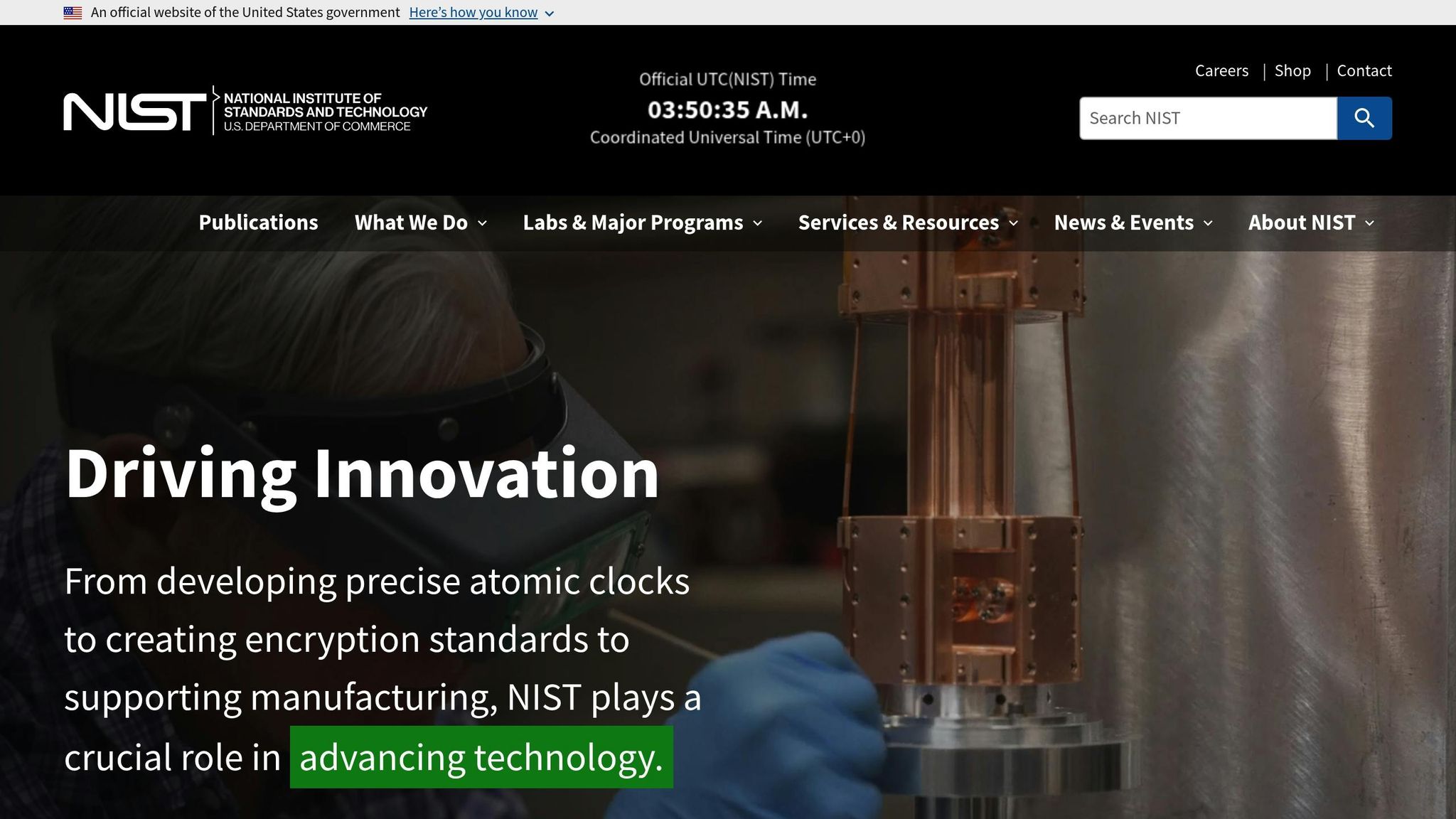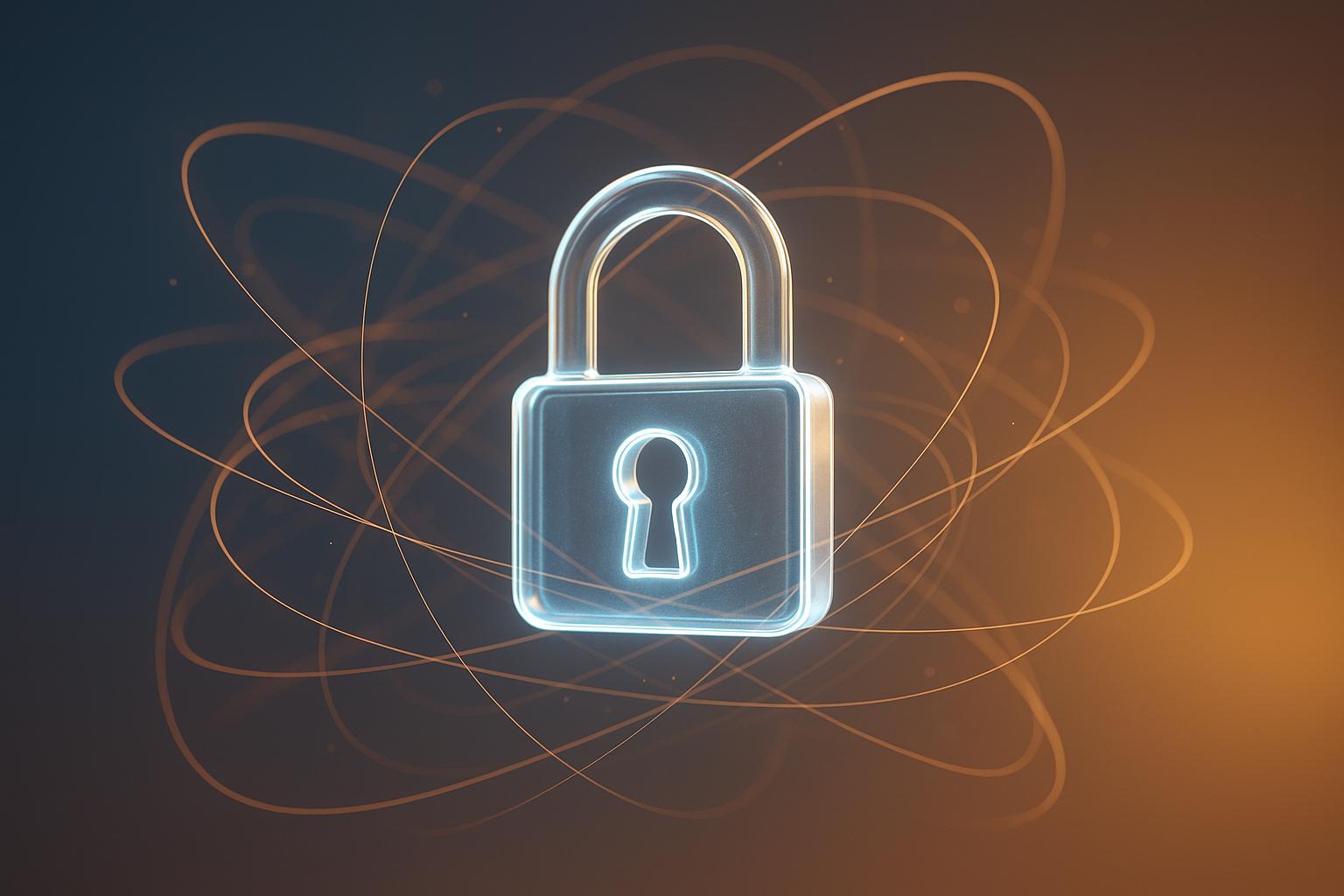The rise of quantum computing is set to disrupt existing encryption methods, making sensitive cloud-stored data vulnerable. Post-quantum cryptography (PQC) offers a solution by using algorithms resistant to quantum attacks. Businesses relying on cloud services must act now to safeguard their data from future risks. Key points to consider:
- Quantum Threats: Algorithms like RSA and ECC, widely used in cloud security, could be broken by quantum computers.
- Cloud Vulnerabilities: TLS, data-at-rest encryption, and digital signatures are at high risk.
- Industries at Risk: Finance, healthcare, government, and critical infrastructure face heightened exposure.
- NIST Standards: Algorithms like CRYSTALS-Kyber and CRYSTALS-Dilithium are being standardised to counter quantum threats.
- Action Steps: Audit current encryption, test PQC algorithms, and plan a phased migration to quantum-safe systems.
Delaying PQC adoption could leave your data exposed to retroactive decryption. Early preparation ensures long-term security and compliance.
AWS re:Inforce 2023 - Post-quantum cryptography migration strategy for cloud services (DAP302)

Current Quantum Computing Threats
Quantum computing is progressing at a remarkable pace. Leading technology companies are pouring resources into research to boost qubit counts and refine error correction techniques. These advancements, particularly in stabilising quantum hardware and improving error management, could completely alter the cryptographic landscape in the coming decades. Moreover, the availability of quantum computing resources through cloud providers is shifting the technology from academic labs to commercially accessible tools. This evolution poses a direct challenge to current cloud security frameworks.
Quantum Computing Development Timeline
The race to develop quantum computers that can disrupt existing cryptographic systems is heating up. Major players in the tech industry are heavily investing in increasing qubit capacity and advancing error correction. These efforts aim to overcome the challenges that have historically limited quantum computing's potential. As cloud providers begin offering quantum computing services, the technology is moving beyond theoretical research into practical, real-world applications. This rapid development is already pressuring existing cloud security protocols to adapt.
Cloud Security Weaknesses Quantum Computing Can Exploit
Cloud environments, due to their interconnected nature, present multiple opportunities for potential attackers.
Many of today’s cloud security measures - such as those protecting HTTPS, API communications, and digital certificates - rely on cryptographic algorithms that quantum computers could eventually break. This highlights the urgency of transitioning to post-quantum encryption standards.
Key exchange protocols, which are essential for establishing secure communications between users, applications, and data centres, are particularly vulnerable. A quantum system capable of breaking these protocols would jeopardise the confidentiality of sensitive data.
The complexity of hybrid cloud setups and container orchestration adds further risks. These systems introduce additional points of vulnerability that quantum attacks could exploit. Many container orchestration platforms rely on encryption methods that may not withstand quantum decryption, potentially exposing entire microservices architectures to attacks.
Another critical concern is database encryption. Cloud databases often store decades' worth of sensitive information. If encryption standards are compromised in the future, attackers could retroactively access years of confidential data, creating a massive security breach.
Industries Most at Risk
Certain industries face heightened risks due to their reliance on sensitive data and long-term encryption.
Financial Services: This sector manages vast amounts of private and economic data. A breach here could lead to severe financial and reputational damage on a global scale.
Healthcare: With its dependence on cloud-based electronic health records, the healthcare sector is particularly vulnerable. Long-term storage of critical patient data makes it a prime target for attackers if encryption fails.
Critical Infrastructure: Energy, water, and telecommunications systems are vital to national security. Cybersecurity agencies have stressed the importance of adopting quantum-resistant measures to protect these sectors from potential quantum-enabled threats.
Government and Defence: Sensitive government communications and defence operations are at risk. State-sponsored adversaries may already be collecting encrypted data, anticipating future quantum breakthroughs that could decrypt it.
Pharmaceuticals: Drug research and clinical trial data hold immense value over time. A breach could give adversaries access to proprietary research, undermining competitive advantages.
Automotive Industry: As connected vehicles generate and store increasing amounts of cloud-based data, this sector faces emerging risks of quantum-related attacks.
Understanding these risks is essential for organisations as they begin transitioning to quantum-resistant encryption. Proactive steps in this direction can help safeguard sensitive data and maintain trust in an increasingly uncertain security landscape.
NIST Post-Quantum Algorithms for Cloud Security

As the risks posed by quantum computing become clearer, NIST has stepped up to provide a roadmap for safeguarding cloud security. The National Institute of Standards and Technology (NIST) is leading the charge in standardising post-quantum cryptographic algorithms that can withstand both classical and quantum attacks. These efforts are crucial for organisations aiming to secure their cloud infrastructures against emerging quantum threats, especially as cloud-related vulnerabilities continue to grow.
NIST-Approved PQC Algorithms
NIST is actively evaluating algorithms designed to resist quantum-based attacks, focusing on protecting critical cryptographic operations. Among the top contenders is CRYSTALS-Kyber, which has shown strong performance as a secure key exchange mechanism, particularly in demanding cloud environments. For digital signatures, CRYSTALS-Dilithium stands out as an efficient option, while SPHINCS+ offers a stateless, hash-based alternative with unique security assumptions. These algorithms rely on mathematical problems that even quantum computers are unlikely to solve, ensuring a robust defence.
How Cloud Providers Are Adopting PQC Standards
Cloud providers are already taking significant steps to integrate these new cryptographic standards. Many are adopting a hybrid approach, combining traditional algorithms with quantum-resistant ones to maintain compatibility while enhancing security. This gradual transition allows systems to adapt without disrupting existing services.
However, implementing post-quantum algorithms isn't without challenges. These methods often require larger key sizes and more computational power compared to traditional cryptography. To address this, providers are optimising both hardware and software to minimise performance issues. Rigorous testing ensures that these quantum-resistant protocols can seamlessly work with current customer infrastructure, third-party integrations, and legacy systems. This careful approach helps maintain the balance between enhanced security and operational efficiency.
Need help optimizing your cloud costs?
Get expert advice on how to reduce your cloud expenses without sacrificing performance.
How to Migrate to Post-Quantum Cryptography in the Cloud
Switching to post-quantum cryptography is no small task. It requires careful planning and a thorough understanding of your current cryptographic systems.
Audit Your Current Cryptographic Systems
Before preparing for quantum threats, you need to take stock of your existing cryptographic setup. Start by identifying and cataloguing all cryptographic assets - this includes certificates, keys, and protocols used across devices and platforms [1][2]. Organisations often discover more dependencies than expected, especially when dealing with legacy systems or unapproved IT setups.
Pay close attention to the cipher suites, key sizes, and protocol versions in use. Key protocols like TLS, SSH, and VPN should be a priority since they are common points of access. It’s also crucial to understand how certificates are managed and where encryption keys are generated and stored. This can reveal potential vulnerabilities [1].
To make this process efficient, use automated tools and seek expert reviews [3]. Once you’ve mapped your cryptographic environment, conduct a quantum risk assessment. Focus on prioritising assets based on their data sensitivity, expected lifespan, and vulnerability - key exchange mechanisms are particularly at risk. Adopting a structured framework like the MITRE Quantum Framework can help ensure your risk assessment is thorough and actionable [3].
With a complete inventory and a clear risk profile, you’ll be ready to plan your migration strategy.
PQC Migration Strategies
Shifting to post-quantum cryptography should be done in stages. Start by testing NIST-approved algorithms in controlled environments. Pilot deployments can help you evaluate how these algorithms perform and whether they are compatible with your existing systems.
A phased rollout is a practical way to manage the transition. For instance, you could begin by applying post-quantum measures to new deployments or systems with shorter data retention periods. This approach allows you to gain experience while maintaining stability for your critical systems.
You’ll also need to check your cryptographic libraries to ensure they support NIST-approved algorithms. Additionally, evaluate whether your cloud infrastructure can handle the increased computational demands of these algorithms [1]. This assessment will help you decide if scaling or other adjustments are necessary to protect against quantum-enabled attacks.
Key Management Best Practices for PQC
Strong key management is essential as you update your cryptographic framework. Assign clear ownership and accountability for every cryptographic component [1]. Clearly define which teams are responsible for managing keys across various systems and applications to ensure everyone is aligned during the migration.
It’s equally important to revise and test your backup and recovery processes for quantum-resistant keys. This ensures your organisation can maintain business continuity even in the face of unexpected challenges.
For organisations seeking expert help in navigating this complex transition, Hokstad Consulting provides specialised cloud security services. Their expertise in cloud infrastructure optimisation and security auditing can make your migration to quantum-safe environments both effective and aligned with your long-term security goals in a quantum-driven future.
Hokstad Consulting's Quantum-Safe Cloud Security Services

Hokstad Consulting extends its expertise in cloud migration and integration by offering specialised services designed to protect your cloud infrastructure against quantum-based threats. Their solutions combine cutting-edge security protocols with operational efficiency, ensuring businesses remain secure without sacrificing performance. Here's how their services can complete your quantum-safe strategy.
Quantum-Safe Cloud Migration Support
Hokstad Consulting provides tailored strategies for migrating to quantum-resistant systems, ensuring a smooth transition while maintaining robust security. By leveraging their expertise, organisations can reduce cloud costs by up to 50% while integrating advanced security measures. Whether you're using a public, private, or hybrid cloud model, their migration plans are customised to fit your infrastructure needs, offering continuous protection throughout the process.
PQC Integration and Automation
Hokstad Consulting integrates post-quantum cryptographic (PQC) protocols into existing cloud systems using automated CI/CD pipelines and bespoke solutions. Their DevOps transformation services ensure that security updates and essential changes are deployed quickly and consistently. Additionally, their capabilities in AI and intelligent agents enable advanced monitoring to detect and address vulnerabilities as quantum technologies evolve, keeping your systems future-ready.
Cloud Security Audits and Monitoring
To stay ahead of quantum threats, regular security audits and performance checks are vital. Hokstad Consulting offers ongoing assessments to identify areas for improvement and ensure that quantum-safe measures remain effective. Their flexible engagement models and on-demand DevOps support allow for rapid responses to emerging threats, keeping your cloud infrastructure secure and resilient over time. These audits and monitoring efforts align seamlessly with their migration and integration services.
Building Quantum-Safe Cloud Security
The looming threat of quantum computing is not a distant concern - it's already shaping the way cybercriminals operate. Hackers are actively collecting encrypted data today, with the intention of decrypting it in the future when quantum computers become capable of breaking current encryption standards [4][5]. This means that sensitive information stored in your cloud infrastructure could be at risk, even retroactively, once quantum decryption becomes feasible.
The adoption of quantum-safe encryption is still in its infancy, and the numbers paint a worrying picture. Only about 5% of enterprises have implemented quantum-safe algorithms. Similarly, just 6% of the 186 million SSH servers online currently support post-quantum cryptography [5][6]. On the brighter side, over 20% of OpenSSH servers have already integrated quantum-safe encryption, showing that some organisations are taking proactive steps [6].
Delaying the adoption of quantum-safe measures could lead to irreversible exposure and significant financial consequences [4]. As quantum computing evolves, so do AI-driven cyberattacks, which are increasingly targeting weaknesses in encryption. Traditional security methods simply won’t hold up against the power of quantum decryption [4].
Key Steps for Businesses
Given these risks and the slow pace of adoption, businesses need to act now to safeguard their cloud environments. Start by auditing your current cryptographic systems to identify vulnerabilities, especially in assets that may soon fall under regulatory requirements. This assessment is the cornerstone of a tailored migration strategy that aligns with your organisation's specific needs.
Early action is critical. Waiting too long can result in rushed, uneven transitions, leaving your infrastructure exposed and out of compliance [6]. Regulatory bodies are likely to enforce quantum-safe encryption standards for critical assets, so being proactive not only ensures compliance but also gives you a competitive edge.
Transitioning to post-quantum cryptography isn’t a simple task - it requires expertise in cloud security and advanced cryptographic protocols. Partnering with professionals can help ensure your migration is smooth, cost-effective, and secure. For example, Hokstad Consulting specialises in integrating quantum-safe measures while optimising costs and automating deployment processes.
The time to act is now. Strengthen your defences today to avoid the chaos of rushed migrations tomorrow.
FAQs
What makes post-quantum cryptography different from traditional methods used in cloud security?
Post-quantum cryptography (PQC) is all about preparing for the day when quantum computers become powerful enough to crack traditional encryption methods like RSA and ECC. These older systems depend on mathematical problems that quantum computers could potentially solve much faster than today’s classical machines.
What sets PQC apart is its reliance on different mathematical principles, ones that are thought to hold up against quantum-powered attacks. Unlike quantum cryptography, which leverages the laws of quantum physics for security, PQC focuses on building algorithms that can endure the advancements in quantum computing. For businesses aiming to protect their cloud systems from future quantum risks, this area of cryptography is becoming increasingly important.
How can businesses prepare their cloud infrastructure for post-quantum cryptography?
To get ready for the era of post-quantum cryptography, businesses should begin by pinpointing and classifying their sensitive data. This step helps determine which assets are most vulnerable to potential quantum computing threats. Keeping track of new post-quantum cryptographic (PQC) standards and algorithms, such as lattice-based cryptography, is equally crucial. Testing these algorithms within your existing cloud infrastructure can reveal how well they perform and integrate.
Another key step is crafting a solid migration plan. This involves preparing for the step-by-step implementation of PQC algorithms to ensure a seamless shift while reducing the risk of security gaps. Starting early will put businesses in a stronger position to tackle future quantum computing challenges and maintain robust cloud security.
Why should industries like finance and healthcare prioritise adopting quantum-resistant encryption?
Industries like finance and healthcare deal with enormous volumes of sensitive information, from financial transactions to patient records. The rise of quantum computing poses a serious challenge here, as it could render current encryption methods ineffective, exposing this critical data to potential breaches.
Switching to quantum-resistant encryption standards is crucial to protect data privacy, uphold public confidence, and stay in line with stringent regulatory demands. Embracing quantum-safe protocols today allows organisations to prepare for the future and reduce the risk of disruptions from quantum-based threats.
